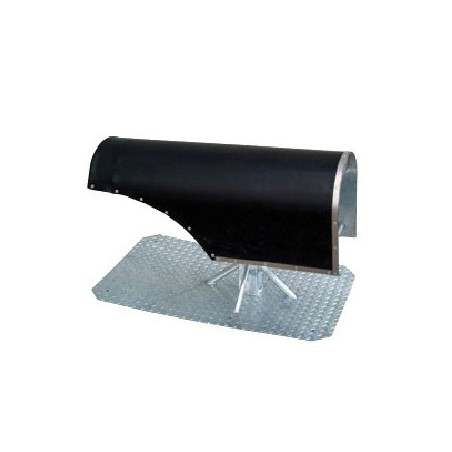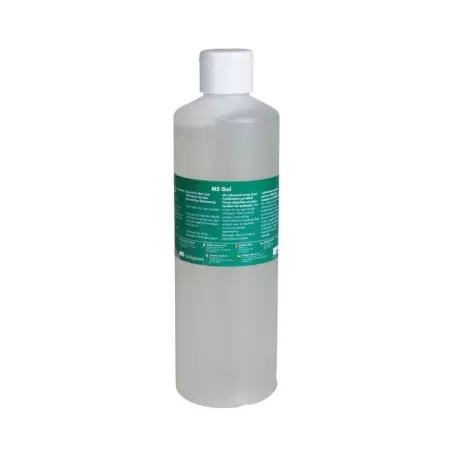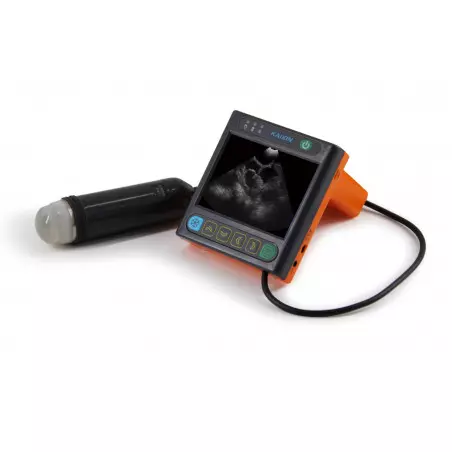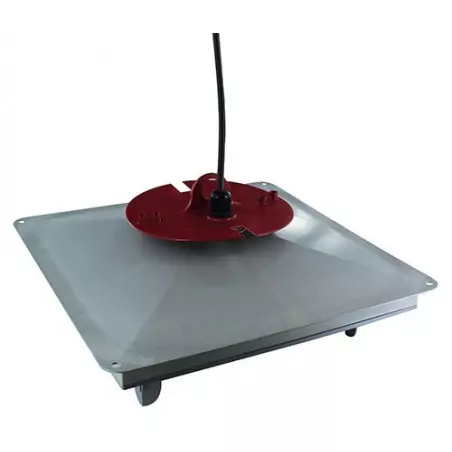In farms, the sows are usually fed a conventional diet, the composition of which is based on the average herd’s energy and nutrient (i.e. amino acids and minerals) requirements. However, there is great heterogeneity between sows, even of the same physiological stage, in terms of their nutritional needs and their production responses. Therefore, with a conventional diet, there will be under- or over-fed sows which can lead to reproductive problems, extra feed costs, and environmental losses. There is a need to determine whether taking into account individual nutritional requirements and their variations over time improves sow performance. This new feeding strategy called “precision feeding” or “tailored feeding” aims at distributing at the right time to the right animal an optimal ration in terms of quantity and composition.
Nutritional models and new technology (sensors, automatons e.g. feeders, Photo 1), bring opportunities to measure and integrate individual variability into models able to estimate the nutrient requirements. At the French National Research Institute for Agriculture, Food and Environment (INRAE), two decision support tools were built with Python (Gaillard et al., 2019; Gauthier et al., 2019) on the basis of the InraPorc model (Dourmad, 2008) and automatic feeders. One can be used for the gestating sows and the other for the lactating sows. In both cases, the optimal energy and nutrient supplies are calculated each day and for each sow taking into account the information available on the farm: sow’s breed, age, litter size, body condition at insemination and objectives at farrowing (body weight and backfat thickness). Herd historical data are also used to predict other parameters required by the model (e.g. litter size and weight, sow’s target body weight at the end of the gestation). Based on the requirements’ estimations, the optimal feed allowance and composition are calculated each day and for each sow and this information is transmitted to the automatic feeder.
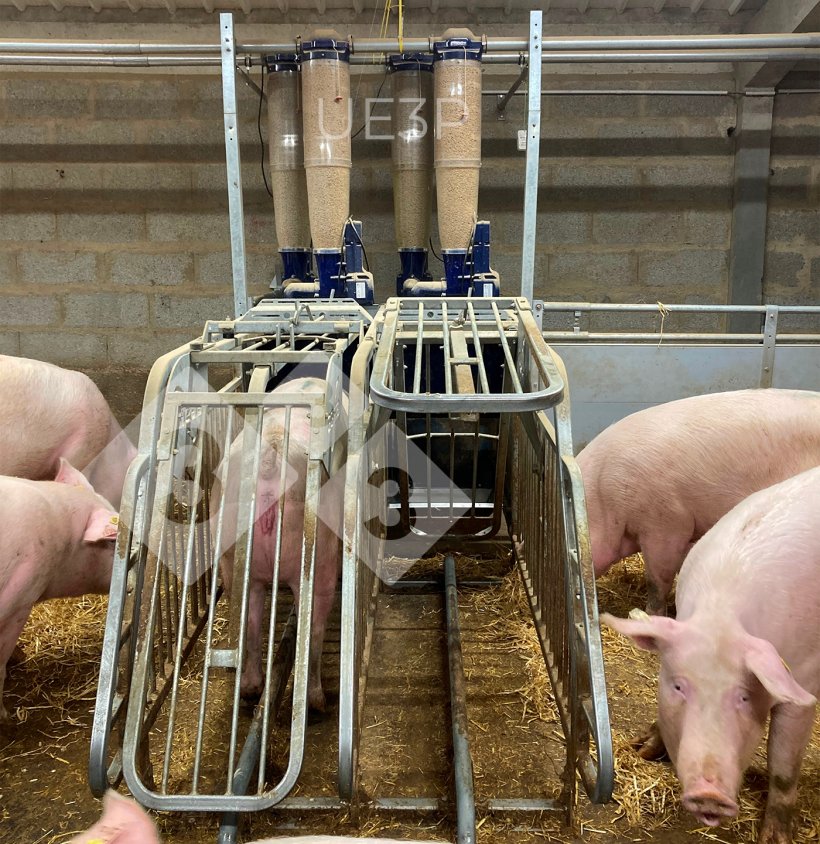

The approach was tested on-farm at the Experimental Unit for Physiology and Phenotyping of Pigs (UE3P) of INRAE for the two aforementioned studies, and in a Canadian commercial farm for the third study. Each lactation or gestation room was equipped with automatic feeders able to mix two diets, to distribute individual rations, and to record individual feed intake. The diet contents and number of crossbred Landrace x Large-White sows are described in Table 1. For each experiment, half of the sows were fed a conventional diet and the other half a precision feeding diet during the entire physiological phase (gestation or lactation). For the precision feeding strategy, the ration was obtained by blending daily and for each sow a diet with a high nutrient content and a diet with a low nutrient content to meet the sow’s requirements. The ration for the conventional feeding strategy was obtained by mixing these two diets in fixed proportions for all the sows and days.
Table 1. Number of sows and diet compositions used for the rations in three different experimentations evaluating the interest of the precision feeding strategy (Gaillard et al., 2022; Gauthier et al., 2021 and 2022)
| Gestating sows | Lactating sows | ||
|---|---|---|---|
| Place of experimentation | France | France | Canada |
| Number of sows | 131 | 62 | 479 |
| High nutrient content diet (H diet) | |||
| Metabolizable Energy, MJ /kg | 13.0 | 13.0 | 13.5 |
| Digestible lysine, g/kg | 8.50 | 10.6 | 13.0 |
| Digestible phosphorus, g/kg | 3.27 | 3.78 | 4.50 |
| Low nutrient content diet (L diet) | |||
| Metabolizable Energy, MJ /kg | 12.7 | 12.8 | 13.2 |
| Digestible lysine, g/kg | 3.30 | 4.70 | 6.50 |
| Digestible phosphorus, g/kg | 2.31 | 2.47 | 2.90 |
| Conventional feeding strategy | |||
| Digestible lysine, g/kg | 4.70 | 8.60 | 10.1 |
| Digestible phosphorus, g/kg | 2.57 | 3.33 | 3.78 |
For gestating sows, the results indicate that precision feeding reduced protein intake by approximately 23% without reducing the quantity of feed distributed, and reduced nitrogen excretion by 18%, phosphorus excretion by 9% and feed cost by 4% (i.e. 3.4 € per gestation or 8 € per ton of feed) compared to a conventional feeding strategy (Gaillard et al., 2022). Reproductive performances were not impacted by the feeding strategy.
For the lactating sows at UE3P, precision feeding reduced lysine intake by 14%, feed cost by 2.5% per lactation, and nitrogen and phosphorus excretion by 19 and 13% respectively, without impacting reproductive performances (Gauthier et al., 2021).
In the Canadian farm, precision feeding reduced lysine intake by 23%, feed cost by 12% per lactation, and nitrogen and phosphorus excretion by 28% and 42%, respectively (Gauthier et al., 2022). With precision feeding, litter growth decreased slightly by about 3% and sow body weight loss was slightly higher (7.7 vs. 2.1 kg), which might be due to insufficient amino acids supply for a few sows.
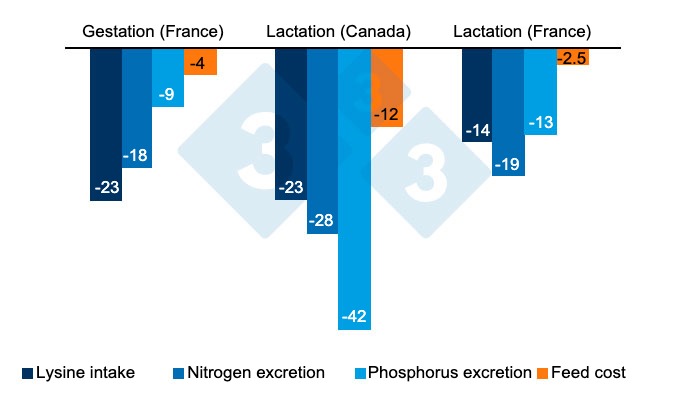
These results underline the interest in precision feeding for sows, during their gestation and lactation, and the use of historical and on-farm individual data to set up the nutritional model. The next step is to implement precision feeding in commercial farms. It will also be relevant to improve the estimation of nutrient requirements by taking into account, for example, the physical activity of the sow impacting the energy requirements. Moreover, until now, this precision feeding strategy is based on energy and lysine requirements and should also consider minerals and fiber which will require an improvement in the feeder design.






